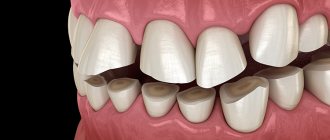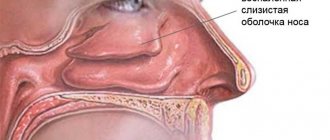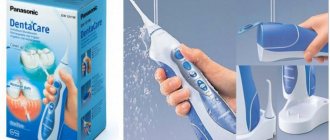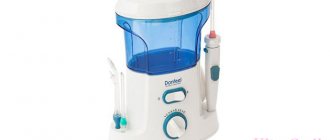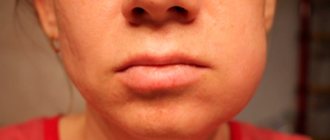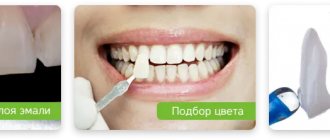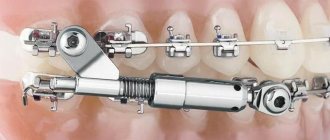The health and beauty of your teeth largely depends on how carefully your oral hygiene is maintained. Cleaning teeth from food debris and plaque with a toothbrush, due to the complexity of the dentition, the presence of hard-to-reach areas, and interdental spaces, is not effective enough. Dentists have long used irrigation in their professional practice to clean teeth. Now the home arsenal of dental care products has been replenished with a new device - an oral irrigator.
Why do you need an irrigator?
Irrigator is a derivative of the Latin word irrigatum, which means “to irrigate.” This is a device that allows you to use water to clean your teeth from organic residues remaining in the mouth after eating. The irrigator does not replace the action of a toothbrush. An irrigator is especially necessary when wearing orthopedic devices (bridges, brackets, brackets and others). With its help, structural elements and the surface of the teeth that come into contact with them are cleaned.
Operating principle of the irrigator
The principle of operation of the irrigator is based on the flow of a very thin stream of water under high pressure onto the elements of the oral cavity to be cleaned. This method of treating the oral cavity not only washes out the smallest food debris and removes plaque from the teeth, but also massages the gums, which improves blood circulation. The device consists of a hydraulic pump, a container for liquid and a handle with replaceable nozzles.
The reservoir is filled with water or solution, under the action of the compressor the pressure rises, and the liquid rushes to the handle with the nozzle. Different irrigator models provide a variety of water jet supply modes, which can be pulsating, spraying, constant, centered, or spraying. The liquid used is plain water or solutions with added agents that enhance the therapeutic and preventive effect of the procedure. Solutions of fluoridated, calcined liquid, antiseptics, antibacterial drugs, herbal infusions, and compositions for strengthening gums are used. Special attachments on the handle ensure that the water jet reaches areas of the dentition that are inaccessible to a toothbrush and floss.
How to care for the device and choose liquid
The length of its service life depends on compliance with the rules of care of the irrigator. It must be stored in a dry place. After use, it is necessary to clean, especially when using herbal infusions. How to do this: fill the tank halfway with boiled water (or bottled drinking water), drain it. Then thoroughly rinse the attachments that have been used and dry them with a towel. The best option is to purchase a model with the option of disinfecting the nozzles with ultraviolet light. This guarantees absolute hygienic safety and time-saving care.
Attention! The irrigator is an electrical device, so under no circumstances should you put it in water, as this can result in electrical injury (electric shock) and damage to the device.
What can be used as a working fluid:
- boiled or bottled water;
- water with the addition of balm intended specifically for irrigators;
- decoction of herbs (subject to preliminary thorough filtration).
The network of dental clinics “Smile” offers services for the prevention of dental and periodontal diseases. Our specialists will carry out professional cleaning and advise you on how to use an oral irrigator. For the convenience of patients, we have a system of family and cumulative discounts.
You can contact any of the branches of our clinic in Moscow, located within walking distance from the metro:
- Art. Alekseevskaya (VDNKh district, etc. Mira), address: st. 3rd Mytishchiskaya house 3, building 2;
- Art. Shelepikha, address: Shelepikhinskaya embankment, address: building 34, building 1.
Prevention is the best protection against disease, don’t forget about it. Come to us for professional prevention and receive recommendations for home hygiene care. We are waiting for you every day!
Benefits of an irrigator
The benefit of the irrigator is better cleaning of the oral mucosa, surface of the teeth, interdental spaces, as well as orthopedic structures. And the absence of a biological substrate for the proliferation of bacteria and the rotting of food debris is the prevention of the development of dental diseases. Medical studies have found that a three-second treatment with pulsating water using an oral irrigator removes up to 99.9% of bioplaque on teeth.
Oral irrigator features:
- Significantly reduces the risk of developing caries.
- Promotes rapid healing of gums through micromassage.
- Disinfects and refreshes the oral cavity with antiseptic solutions.
- Cleans gum pockets and prevents the development of periodontal disease.
- Treats the oral mucosa with medicinal solutions for stomatitis
- Prevents the deposition of pigment on the surface of tooth enamel when smoking, drinking strong coffee, tea, red wine.
- Removes plaque from the mucous membrane of the tongue and gums, which reduces bacterial contamination of the oral cavity.
- Prevents destruction of the enamel coating of teeth when installing braces, braces and other orthopedic devices.
- To reduce trauma to soft tissues due to bleeding and loosening of the gums, replace the toothbrush.
Seven signs to look out for
Do you want to check how your toothbrush copes with its function and whether the Waterpik irrigator has advantages? You can assess the condition of your teeth using these signs:
- presence of caries,
- the presence of tartar (hard plaque that hardens on the teeth as a result of insufficient daily brushing),
- presence of bacteria on teeth,
- presence of gum disease (bleeding and others),
- Are your teeth hypersensitive (do they react to things that are too cold or too hot with aching pain),
- “yellowishness” of teeth or the presence of so-called dark plaque,
- freshness of breath, which is also reflected by the presence of food debris between the teeth.
The detection of several of the seven signs directly indicates that the quality of oral hygiene is insufficient. Clinical studies prove that long-term use of the Waterpik irrigator significantly reduces the risk of identifying seven so-called signs of unhealthy teeth.
Types of irrigators
Types of irrigators differ from each other in technical characteristics, design, and operating principles. Stationary models are placed in the bathroom and operate from the mains. They are equipped with a large capacity for liquid and have a powerful engine that creates a high level of pressure. The device is usually used by the whole family, so it comes with many attachments.
Flaws:
- The energy source is too small to create the required water jet pressure.
- The need to frequently replace batteries or charge the battery.
- The volume of water is not enough to fully clean the oral cavity.
- Flow irrigators are attached to a water tap and use the pressure of the water supply system. Special tap valves allow you to regulate the fluid pressure.
- Mechanical types of irrigators are now rarely used. These are devices in which the pressure required to produce a jet is achieved by mechanical action on the piston. There is a key on the body of the device that is pressed to increase the pressure in the vessel with the liquid. The efficiency of such a device is low
- Tap water mixed with chlorine and heavy metal salts enters the oral cavity.
- There is no pulsation mode.
- Often the water pressure is not enough for effective cleaning.
- Modern models use the latest fine-bubble cleaning method, which is considered the most effective.
- The pulsation mode also promotes the rapid removal of microparticles of organic substances from teeth and orthopedic structures.
Types of removable attachments
Several types of attachments have been developed to perform various oral hygiene tasks:
- The standard one is used for daily brushing of teeth.
- Periodontal is designed to cleanse gum pockets.
- Nozzle for removing plaque from the tongue.
- The orthodontic attachment is used to care for braces and other dental devices.
- The brush attachment performs the work of a classic toothbrush and massages the gums.
- The teeth whitening attachment is used in the process of cleaning and polishing the enamel.
- Manufacturers of irrigators and their features
- In the modern market of dental devices, irrigators are presented in a wide range.
How often should you apply
As already mentioned, using an irrigator is an additional method of hygienic care. The frequency of operation depends on the individual characteristics of the user and the intended purpose:
- to prevent the formation of tartar - 1 time per day, every other day;
- to remove smoker's plaque (as well as with excessive consumption of black tea, coffee and red wine) - daily;
- during pregnancy - daily;
- for problems with gums (gingivitis, periodontitis, periodontal disease) - the frequency of use must be checked with your doctor;
- when wearing braces or installed dentures - twice a day (it is recommended to clean braces after every meal).
Specialist clarification: if you have undergone surgery in the oral cavity (tooth extraction, gum recession, implantation, etc.), then the use of an irrigator is possible only with the permission of the surgeon.
Dentist advice
Before you start using the device, you need to consult a dentist who will help you choose the optimal fluid supply mode, frequency of use, and solution composition. Compliance with all operating rules is the key to safe use of the irrigator. Rules for using the irrigator:
- Cleaning should begin with a gentle regime, gradually increasing power over 7-10 days.
- It is not recommended to use the device earlier than 24 hours after installing any orthodontic structures in the oral cavity.
- The liquid stream should be directed towards the teeth at a right angle.
- It is permissible to use an irrigator for children from 6-7 years of age, always under adult supervision. A high-pressure jet of water entering a child's windpipe can cause tracheal spasm and asphyxia.
- Long-term use of aseptic solutions can disrupt the normal microflora of the oral cavity and cause dysbacteriosis.
- The device can be used for gingivitis and periodontitis only during remission.
- The duration of the procedure is 5-10 minutes.
Who should buy
In addition to users of braces and other orthodontic systems, people who:
- want to keep their smile healthy;
- prone to the formation of large amounts of stone;
- fight the problem of unpleasant odor;
- suffer from increased bleeding gums;
- have crooked teeth, due to which certain areas cannot be properly cleaned.
When deciding which mechanism is best, it is important to understand that it only serves as an additional means of cleansing the mouth. It is impossible to replace a brush or, for example, floss with a device of this type.
Dentists recommend using the system three times a week and only if there is an urgent need. This is quite enough to ensure that the gums remain healthy, and “deposits” of food residues do not form in the interdental spaces.
